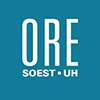To subscribe to the ORE seminar mailing list, click here.
For a (working draft) list of upcoming seminars, click here.
If you are interested in giving an ORE seminar, please contact us at nosal [at] hawaii [dot] edu.

- This event has passed.
Seminar: Investigating Helmholtz Mode for Marine Hydro-Kinetic Energy
13 November 2019 @ 3:15 pm - 4:15 pm
Reza Ghorbani, PhD
Associate Professor
Department of Mechanical Engineering
University of Hawai’i, Mānoa
Short relatively deep tidal basins, which are connected to the open sea by a narrow strait, may exhibit either an amplified (resonant), or damped (choked) response to the tide at the entrance. The sole mode added to this system when the basin communicates with a tidal sea through a narrow strait is the pumping or Helmholtz mode, characterized by a periodic mass exchange through the narrows and associated spatially uniform elevation change within the basin. This is generally also the most energetic mode of such a basin. The Helmholtz mode has been employed to explain tidal oscillations in, for instance, Lake Maracaibo and even in a system as big as the Gulf of Mexico in order to explain the relatively large amplitudes of its diurnal tides. The Helmholtz mode can be seen in small basins exposed to sea waves by a narrow channel known as tidal bowls. Preliminary experiments were carried out by REDLab measuring the water surface, demonstrating a strong correlation to the theoretical Helmholtz mode model catalyzing the proposed work to study effective applications of this model toward a new class of wave energy converter (named as Halona WEC) under normal and harsh wave conditions. Halona has a low number of moving elements, which makes it robust to harsh ocean climate and might become a breakthrough in wave energy converter systems in terms of efficiency and reliability. Here I present the concept, design and history of Halona WEC. The project is still under development at UH.
